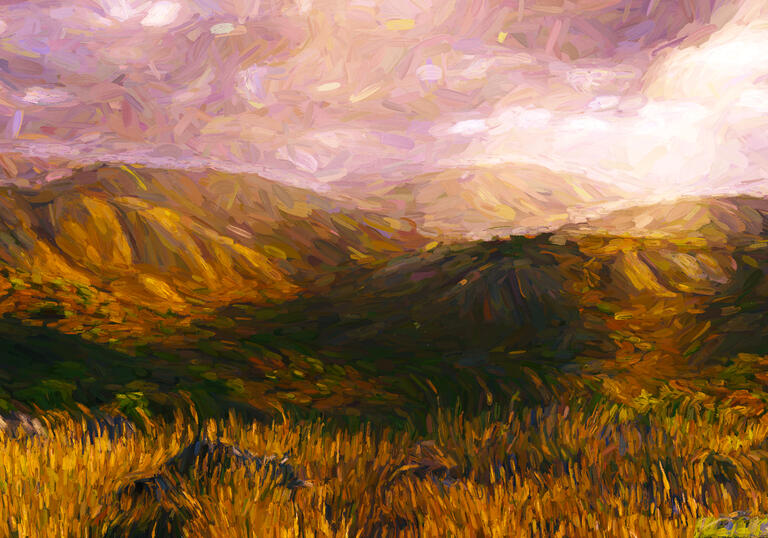
Programme and performers
Joseph Haydn The Seasons
1. Spring
2. Summer
3. Autumn
4. Winter
Academy of Ancient Music
Laurence Cummings conductor
Rachel Nicholls* soprano
Benjamin Hulett tenor
Jonathan Lemalu bass-baritone
Nina Dunn Studio video and projection design
Martin Parr staging director
*Due to ill-health, Sophie Bevan has sadly had to withdraw from this engagement. We're grateful to Rachel Nicholls for agreeing to step in at short notice.
Text
1 Introduction and Accompagnato
Simon
See Winter, stern and gloomy, flees
To farthest reaches of the north.
And foll’wing at his beck,
His blust’ry ruffians quit the vales,
With dreadful groans and howling.
Lucas
From tow’ring crags the melting snows
In slushy torrents swiftly roll.
Hannah
And lo! from southern shores
Breathe softest zephyrs, warm and mild,
Sweet messengers of Spring!
2 Chorus
Come, gentle Spring!
Thou gift of Heaven, come!
From frozen wint’ry grave, bid drowsy Nature rise!
The smiling Spring is almost here,
The linden blossom soon will cheer,
And all will burst to life again.
Take heed! Do not rejoice so soon,
For creeping mists and freezing fogs abound,
And Winter oft returns to spread o’er shoots and buds,
A deadly, malicious frost.
Come gentle Spring!
Thou gift of Heaven, come!
Descend upon our verdant plains.
O come, gentle Spring,
Make haste, do not delay!
3a Recitative
Simon
From Aries shines the bright’ning sun, o’er all the world below.
Now cold and dampness yield to kindly breezes, warm and mild.
The frozen earth breaks free once more, and radiant is the firmament above.
3b Song
Simon
With eagerness the countryman sets forth to till the soil,
Through furrows long he whistling strides, and tunes a cheerful lay.
With measur’d gait and careful tread he scatters wide the seed,
And prays the faithful soil will bear, in time, a golden crop.
4a Recitative
Lucas
The countryman has paid his dues;
No care nor labour has he spared,
So gen’rous Nature will his diligence reward,
And thus to Heav’n he turns his humble pray’rs.
4b Chorus with solos
Lucas and Chorus
Heav’n be gracious, Heav’n be bounteous.
Open thou, and pour thy blessings o’er our fertile plains below.
Lucas
Let glist’ning dews revive our pastures!
Simon
Let show’rs of rain refresh our meadows!
Hannah
Let softest breezes warm the air, and let the
sun shine purest rays!
Hannah, Lucas, Simon and Chorus
For these abundant gifts we pray, and for thy
bounty, thanks be giv’n.
5a Recitative and Accompagnato
Hannah
Our fervent pray’rs are heard;
A warming breeze arises
And fills the sky with downy billows.
They rise aloft, they tumble down,
And pour their riches o’er the earth,
The pride and joy of Nature fair.
5b Duet and Chorus with solos
Hannah
O what charming sights delight us in the
prospect fair.
Come ye maidens, let us wander through the
flow’ry vales.
Lucas
O what charming sights delight us in the
prospect fair.
Come ye fellows, let us wander ’midst the
meadows green.
Hannah
See the lilies, see the roses, see the flowers all!
Lucas
See the farmland, see the bowers, see the
pastures all!
Chorus (Lads and Lasses)
O what charming sights delight us in the
prospect fair, etc.
Hannah
See the landscape, see the waters, see the
glitt’ring sky!
Lucas
All is stirring, all is quiv’ring, hark how lively
Nature wakes!
Hannah
See the newborn lambs are gamb’lling,
Lucas
See the shoals of fish are swimming,
Hannah
See the swarms of bees are buzzing,
Lucas
See the flocks of birds are flutt’ring,
Chorus (Lads and Lasses)
All is stirring, all is quiv’ring, hark how lively
Nature wakes!
O what pleasures, O what wonders fill our
gladden’d hearts.
Sweetest yearnings, gentlest longings soon
arise within our breasts.
Simon
Ev’ry feeling, ev’ry passion is the mighty
Creator’s will.
Chorus
Let us honour, let us worship, let us laud Him,
let us praise His name.
Let our voices hymn His glory and resound on
high!
Wonderful, bountiful, infinite God.
Hannah, Lucas, Simon
With Thine abundant blessings, mankind hast
Thou reviv’d.
With Thine o’erflowing goodness, mankind
hast Thou refresh’d.
Chorus
Hymns of praise we sing to Thee,
Wonderful, bountiful, infinite God.
English translation © Paul McCreesh
Artist biographies
Academy of Ancient Music is an orchestra with a worldwide reputation for excellence in Baroque and Classical music. Using historically informed techniques, period-specific instruments and original sources, it brings music vividly to life in committed, vibrant performances.
Established nearly 50 years ago to make the first British recordings of orchestral works using original instruments, AAM has released more than 300 albums to date, collecting countless accolades including Classic BRIT, Gramophone and Edison awards. The ensemble now records on its own label – AAM Records – and is the most listened-to period-instrument orchestra online, with over one million monthly listeners on streaming platforms.
Beyond the concert hall, AAM is committed to nurturing the next generation of musicians and music-lovers through its innovative side-by-side learning and participation initiative AAMplify. Working in collaboration with partners at the Guildhall School, London Music Masters, Cambridgeshire Music Hub and others it reaches thousands of children and young people across primary, secondary and tertiary education each year.
AAM is Associate Ensemble at the Barbican Centre and the Teatro San Cassiano, Venice, and Orchestra-in-Residence at the University of Cambridge, Milton Abbey International Summer Music Festival and The Apex, Bury St Edmunds. The 2022/23 season is the second for Music Director Laurence Cummings, who joins the orchestra as it approaches its 50th anniversary next year.
Hall
Location
The Barbican Hall is located within the main Barbican building. Head to Level G and follow the signs to find your seating level.
Address
Barbican Centre
Silk Street, London
EC2Y 8DS
Public transport
The Barbican is widely accessible by bus, tube, train and by foot or bicycle. Plan your journey and find more route information in ‘Your Visit’ or book your car parking space in advance.





